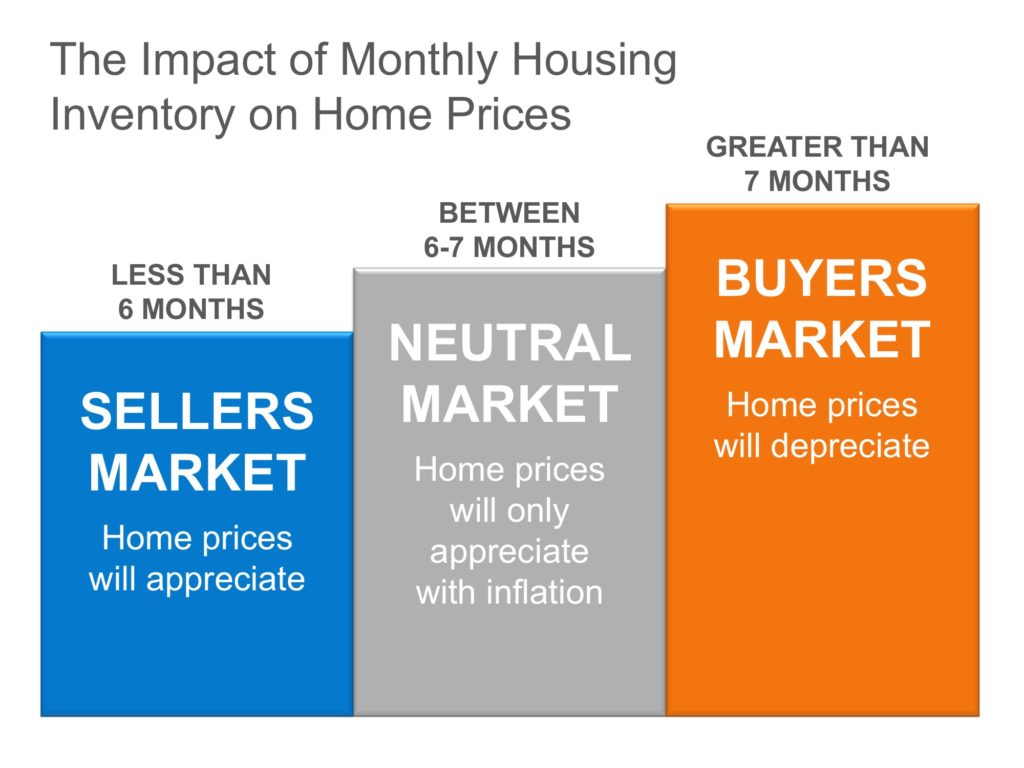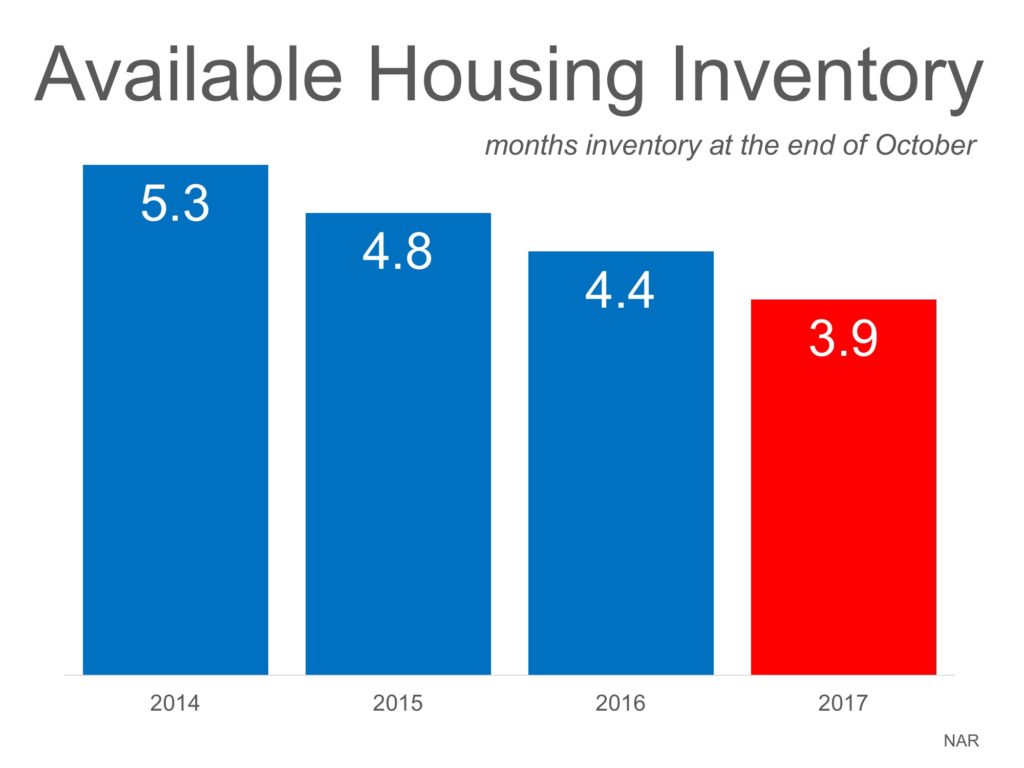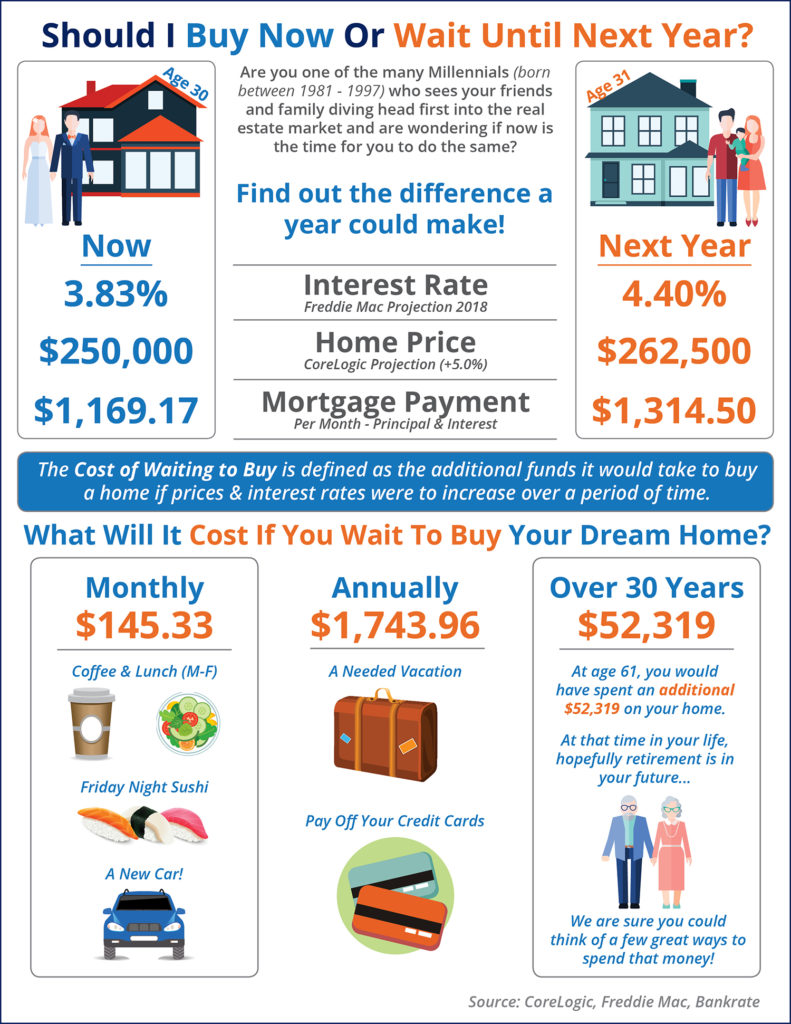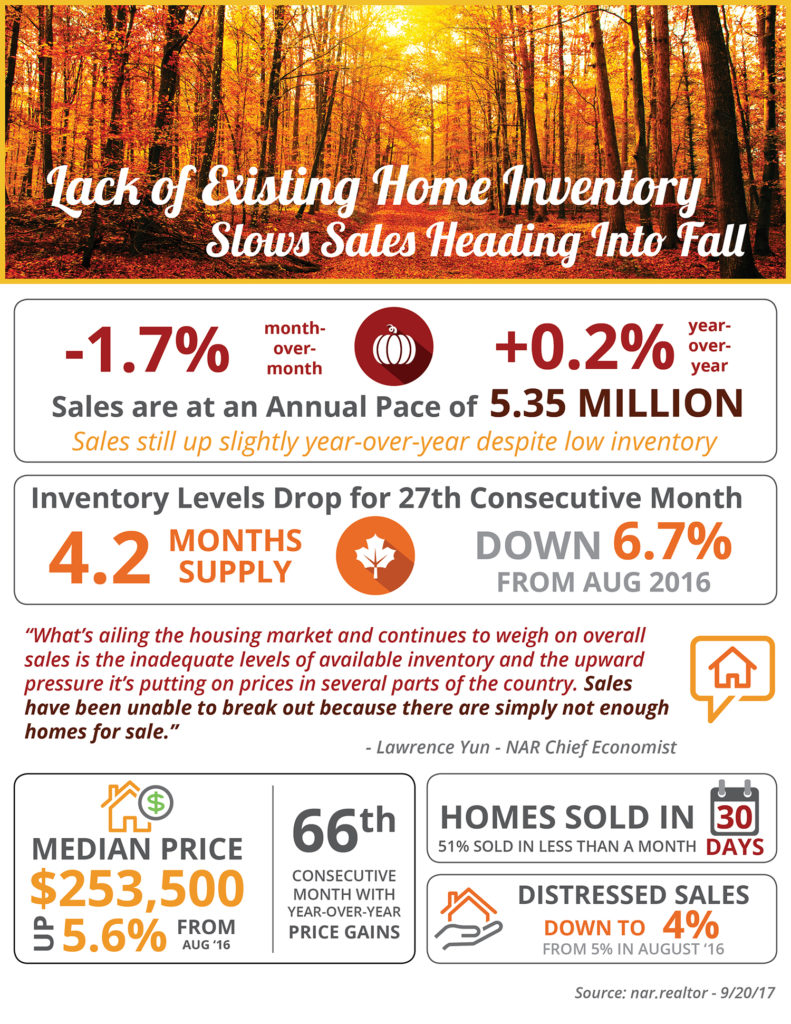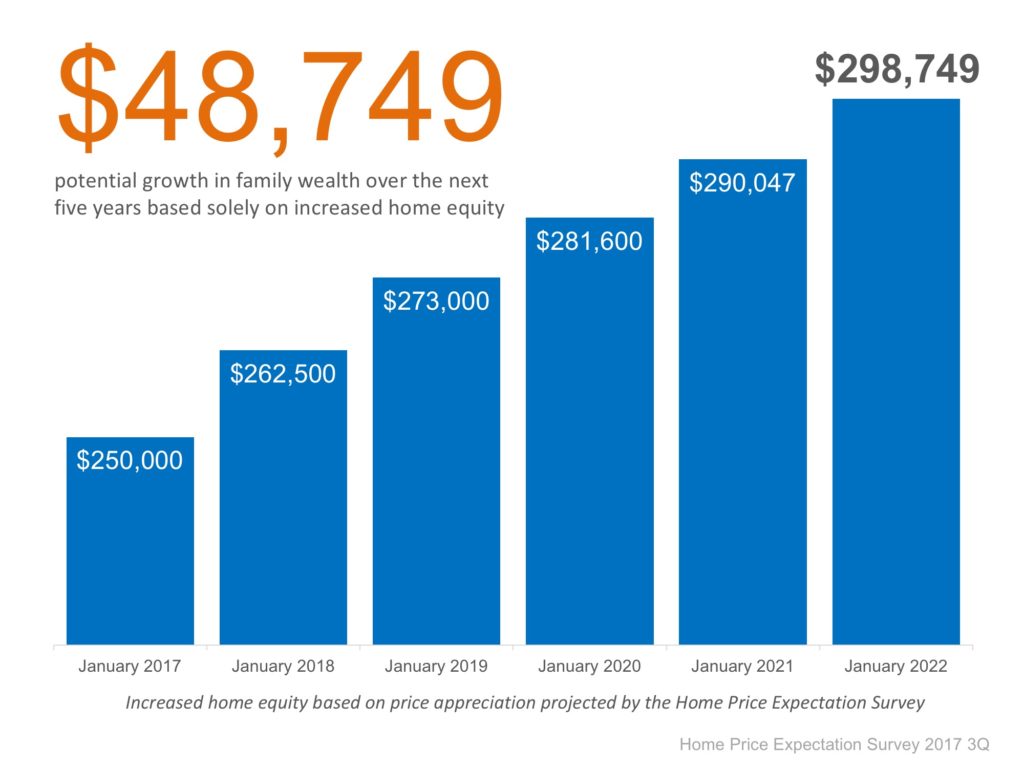Category: Pricing
The Real Reason Home Prices are Increasing
Nov
30
2017

There are many unsubstantiated theories as to why home values are continuing to increase. From those who are worried that lending standards are again becoming too lenient (data shows this is untrue), to those who are concerned that prices are again approaching boom peaks because of “irrational exuberance” (this is also untrue as prices are not at peak levels when they are adjusted for inflation), there seems to be no shortage of opinion.
However, the increase in prices is easily explained by the theory of supply & demand. Whenever there is a limited supply of an item that is in high demand, prices increase.
It is that simple. In real estate, it takes a six-month supply of existing salable inventory to maintain pricing stability. In most housing markets, anything less than six months will cause home values to appreciate and anything more than seven months will cause prices to depreciate (see chart 1).
According to the Existing Home Sales Report from the National Association of Realtors (NAR), the monthly inventory of homes has been below six months for the last four years (see chart 2).
Bottom Line
If buyer demand outpaces the current supply of existing homes for sale, prices will continue to appreciate. Nothing nefarious is taking place. It is simply the theory of supply & demand working as it should.
Posted in Buying Myths, First Time Home Buyers, For Buyers, Housing Market Updates, Move-Up Buyers, Pricing
A Housing Bubble? Industry Experts Say NO!
Nov
09
2017

With residential home prices continuing to appreciate at levels above historic norms, some are questioning if we are heading toward another housing bubble (and subsequent burst) like the one we experienced in 2006-2008.
Recently, five housing experts weighed in on the question.
Rick Sharga, Executive VP at Ten-X:
“We’re definitely not in a bubble.”
“We have a handful of markets that are frothy and probably have hit an affordability wall of sorts but…while prices nominally have surpassed the 2006 peak, we’re not talking about 2006 dollars.”
Christopher Thornberg, Partner at Beacon Economics:
“There is no direct or indirect sign of any kind of bubble.”
“Steady as she goes. Prices continue to rise. Sales roughly flat.…Overall this market is in an almost boring place.”
Bill McBride, Calculated Risk:
“I wouldn’t call house prices a bubble.”
“So prices may be a little overvalued, but there is little speculation and I don’t expect house prices to decline nationally like during the bust.”
David M. Blitzer, Managing Director and Chairman of the Index Committee at S&P Dow Jones Indices:
“Housing is not repeating the bubble period of 2000-2006.”
“…price increases vary unlike the earlier period when rising prices were almost universal; the number of homes sold annually is 20% less today than in the earlier period and the months’ supply is declining, not surging.”
Bing Bai & Edward Golding, Urban Institute:
“We are not in a bubble and nowhere near the situation preceding the 2008 housing crisis.”
“Despite recent increases, house prices remain affordable by historical standards, suggesting that home prices are tracking a broader economic expansion.”
Posted in First Time Home Buyers, For Buyers, Housing Market Updates, Move-Up Buyers, Pricing
Multigenerational Households May Be the Answer to Price Increases
Nov
07
2017

Multigenerational homes are coming back in a big way! In the 1950s, about 21%, or 32.2 million Americans shared a roof with their grown children or parents. According to an article by Realtor.com, “Nearly 1 in 5 Americans is now living in a multigenerational household – a household with two or more adult generations, or grandparents living with grandchildren – a level that hasn’t been seen in the U.S. since 1950.”
Another report that proves this point is the National Association of Realtors’ (NAR) 2017 Profile of Home Buyers and Sellers which states that 13% of home buyers purchased multigenerational homes last year. The top 3 reasons for purchasing this type of home were:
- To take care of aging parents (22%, up from 19% last year)
- Cost savings (17%)
- Children over the age of 18 moving back home (16%, up from 14% last year)
Valerie Sheets, Spokesperson for Lennar, points out that,
“Everyone is looking for the perfect home for any number of family situations, such as families who opt to take care of aging parents or grandparents at home, or millennials looking to live with their parents while they attend school or save for a down payment.”
For a long time, nuclear families (a couple and their dependent children) became the accepted norm, but John Graham, co-author of “Together Again: A Creative Guide to Successful Multigenerational Living,” says, “We’re getting back to the way human beings have always lived in – extended families.”
This shift can be attributed to several social changes over the decades. Growing racial and ethnic diversity in the U.S. population helps explain some of the rise in multigenerational living; “Data suggest that multigenerational living is more prevalent among Asian (28%), Hispanic (25%), and African-American (25%) families, while U.S. whites have fewer multigenerational homes (15%).”
Additionally, women are a bit more likely to live in multigenerational conditions than are their male counterparts (12% vs. 10%, respectively). Last but not least, basic economics.
Valerie Sheets brings to light the fact that home prices have been skyrocketing in recent years. She says that, “As home prices increase, more families tend to opt for living together.”
Bottom Line
Multigenerational households are making a comeback. While it is a shift from the more common nuclear home, these households might be the answer that many families are looking for as home prices continue to rise in response to a lack of housing inventory.
Posted in For Buyers, For Sellers, Move-Up Buyers, Pricing
Low Inventory Causes Home Prices to Maintain Fast Growth
Nov
06
2017

The National Association of Realtors (NAR) released their latest Quarterly Metro Home Price Report last week. The report revealed that severely lacking inventory across the country drained sales growth and kept home prices rising at a steady clip in nearly all metro areas. Home prices rose 5.3% over the last quarter across all metros.
Lawrence Yun, Chief Economist at NAR, discussed the impact of low inventory on buyers in the report:
“Unfortunately, the pace of new listings were unable to replace what was quickly sold. Home shoppers had little to choose from, and many had to outbid others in order to close on a home. The end result was a slowdown in sales from earlier in the year, steadfast price growth and weakening affordability conditions.”
What this means to sellers
Rising prices are a homeowner’s best friend. As reported by the Washington Post in a recent article post:
“The rise in median sales prices has made current homeowners much more willing to sell their home, and that willingness is one of the main drivers behind the inventory that does make it on to the market. While it hasn’t been enough to meet demand, it has made the situation much better, compared with even three or four years ago.”
What this means to buyers
In a market where prices are rising, buyers should take into account the cost of waiting. Obviously, they will pay more for the same house later this year or next year. However, as Construction Dive reported, the amount of cash needed to purchase that home will also increase.
“These factors have created a situation where the market keeps moving the goalposts in terms of the down payment necessary for first-time homebuyers to get into a home.”
Bottom Line
If you’re thinking of selling and moving down, waiting might make sense. If you are a first-time buyer or a seller thinking of moving up, waiting probably doesn’t make sense.
Posted in First Time Home Buyers, For Buyers, For Sellers, Move-Up Buyers, Pricing
The #1 Reason to List Your House, NOW!
Oct
25
2017

The National Association of Realtors (NAR) released the results of their latest Existing Home Sales Report which revealed that sales rose 0.7% month-over-month, but remain 1.5% lower than they were a year ago. Some may look at these numbers and think that now is not a good time to sell their house, but in fact, the opposite is true.
The national slowdown in sales is directly tied to a lack of inventory available for the buyers who are out in the market looking for their dream homes! The inventory of homes for sale has fallen year-over-year for the last 28 months and has had an upward impact on home prices.
NAR’s Chief Economist Lawrence Yun had this to say,
“Home sales in recent months remain at their lowest level of the year and are unable to break through, despite considerable buyer interest in most parts of the country.
Realtors® this fall continue to say the primary impediments stifling sales growth are the same as they have been all year: not enough listings – especially at the lower end of the market – and fast-rising prices that are straining the budgets of prospective buyers.” (emphasis added)
The houses that are on the market are selling fast, too! According to NAR’s Realtors Confidence Index, the median number of days it took for a house to go from listed to under contract over the past three months was 34.
Bottom Line
If you are one of the many homeowners who is debating listing your house for sale this year, the time is now! Let’s get together to discuss the specifics of our market!
Posted in For Buyers, For Sellers, Move-Up Buyers, Pricing
Should I Buy a Home Now? Or Wait Until Next Year? [INFOGRAPHIC]
Sep
29
2017
![Should I Buy a Home Now? Or Wait Until Next Year? [INFOGRAPHIC]| Simplifying The Market](http://d39ah2zlibpm3g.cloudfront.net/wp-content/uploads/2017/09/28125015/20170929-Share-STM.jpg)
Some Highlights:
- The Cost of Waiting to Buy is defined as the additional funds it would take to buy a home if prices & interest rates were to increase over a period of time.
- Freddie Mac predicts interest rates to rise to 4.4% by next year.
- CoreLogic predicts home prices to appreciate by 5.0% over the next 12 months.
- If you are ready and willing to buy your dream home, find out if you are able to!
Posted in First Time Home Buyers, For Buyers, Infographics, Interest Rates, Millennials, Move-Up Buyers, Pricing
How to Get the Most Money from the Sale of Your Home
Sep
25
2017

Every homeowner wants to make sure they maximize their financial reward when selling their home. But how do you guarantee that you receive maximum value for your house? Here are two keys to ensure that you get the highest price possible.
1. Price it a LITTLE LOW
This may seem counterintuitive. However, let’s look at this concept for a moment. Many homeowners think that pricing their home a little OVER market value will leave them room for negotiation. In actuality, this just dramatically lessens the demand for your house (see chart below).
Instead of the seller trying to ‘win’ the negotiation with one buyer, they should price it so that demand for the home is maximized. By doing this, the seller will not be fighting with a buyer over the price, but will instead have multiple buyers fighting with each other over the house.
Realtor.com gives this advice:
“Aim to price your property at or just slightly below the going rate. Today’s buyers are highly informed, so if they sense they’re getting a deal, they’re likely to bid up a property that’s slightly underpriced, especially in areas with low inventory.”
2. Use a Real Estate Professional
This, too, may seem counterintuitive. The seller may think they would make more money if they didn’t have to pay a real estate commission. With this being said, studies have shown that homes typically sell for more money when handled by a real estate professional.
A new study by Collateral Analytics, reveals that FSBOs don’t actually save any money, and in some cases may be costing themselves more, by not listing with an agent.
In the study, they analyzed home sales in a variety of markets in 2016 and the first half of 2017. The data showed that:
“FSBOs tend to sell for lower prices than comparable home sales, and in many cases below the average differential represented by the prevailing commission rate.”
The results of the study showed that the differential in selling prices for FSBOs when compared to MLS sales of similar properties is about 5.5%. Sales in 2017 suggest the average price was near 6% lower for FSBO sales of similar properties.
Bottom Line
Price your house at or slightly below the current market value and hire a professional. This will guarantee that you maximize the price you get for your house.
Posted in For Sellers, FSBOs, Pricing
Lack of Existing Home Inventory Slows Sales Heading into Fall [INFOGRAPHIC]
Sep
22
2017

Some Highlights:
- The National Association of Realtors (NAR) recently released their latest Existing Home Sales Report.
- First-time homebuyers made up 31% of all sales in August.
- Homes are selling quickly with 51% of homes on the market for less than a month.
- A limited supply continues to drive up prices for the 66th consecutive month.
Posted in For Buyers, For Sellers, Infographics, Move-Up Buyers, Pricing
More Americans Say Now is a Good Time to Sell!
Sep
20
2017

Recently released data from Fannie Mae’s National Housing Survey revealed that rising home prices were the catalyst behind an eight-point jump in the net percentage of respondents who say now is a good time to sell. The index is now 21 points higher than it was this time last year.
Overall, 62% of Americans surveyed said that now is a good time to sell (up from 58%), while 26% of respondents said that now is not a good time to sell (down from 30%). The net score is the difference between the two percentages, or 36%.
According to CoreLogic, home prices are now up 6.7% over last year and 78.8% of homeowners with a mortgage in the US now have significant equity (defined as 20% or more).
As home prices have increased, more and more homeowners have realized that now is a good time to sell their homes in order to take advantage of the extra equity they now have.
At the same time, however, rising prices have had the exact opposite impact on the good-time-to-buy scale as many buyers are nervous that they will not be able to afford a home; the net score dropped 5 points to 18%.
Doug Duncan, Vice President & Chief Economist at Fannie Mae, had this to say,
“In the early stages of the economic expansion, home selling sentiment trailed home buying sentiment by a significant margin. The reverse is true today.
The net good time to sell share is now double the net good time to buy share, with record high percentages of consumers citing home prices as the primary reason for both perceptions. Such a sizable gap between selling and buying sentiment, if it persists, could weigh on the housing market through the rest of the year.”
Buyer demand continues to outpace the supply of homes for sale, which has driven prices up across the country. Until the supply starts to better match demand, there will be a gap between the sentiments surrounding buying and selling.
Bottom Line
If you are considering listing your home for sale this year, now is the time!
Posted in For Buyers, For Sellers, Move-Up Buyers, Pricing
How Your Home’s Value Grows Your Family’s Wealth
Sep
05
2017

Over the next five years, home prices are expected to appreciate 3.64% per year on average and to grow by 18.4% cumulatively, according to Pulsenomics’ most recent Home Price Expectation Survey.
So, what does this mean for homeowners and their equity position?
As an example, let’s assume a young couple purchased and closed on a $250,000 home in January. If we look at only the projected increase in the price of that home, how much equity will they earn over the next 5 years?
Since the experts predict that home prices will increase by 5.0% this year alone, the young homeowners will have gained $12,500 in equity in just one year.
Over a five-year period, their equity will increase by nearly $49,000! This figure does not even take into account their monthly principal mortgage payments. In many cases, home equity is one of the largest portions of a family’s overall net worth.
Bottom Line
Not only is homeownership something to be proud of, but it also offers you and your family the ability to build equity you can borrow against in the future. If you are ready and willing to buy, find out if you are able to today!
Posted in First Time Home Buyers, For Buyers, Move-Up Buyers, Pricing
